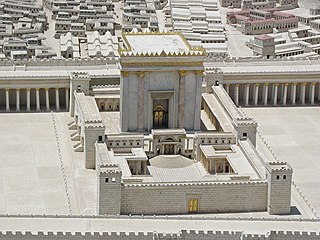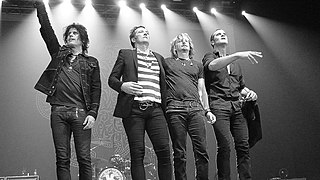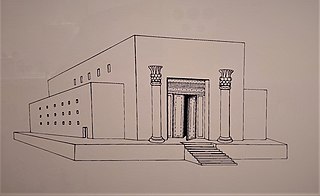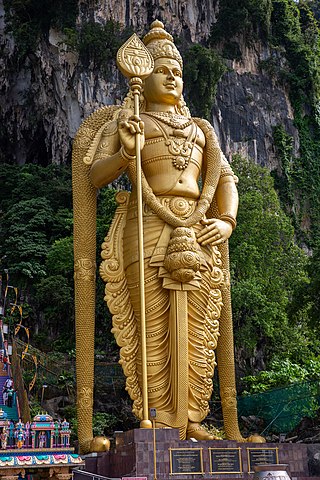
The Temple in Jerusalem, or alternatively the Holy Temple, refers to the two religious structures that served as the central places of worship for Israelites and Jews on the modern-day Temple Mount in the Old City of Jerusalem. According to the Hebrew Bible, the First Temple was built in the 10th century BCE, during the reign of Solomon over the United Kingdom of Israel. It stood until c. 587 BCE, when it was destroyed during the Babylonian siege of Jerusalem. Almost a century later, the First Temple was replaced by the Second Temple, which was built after the Neo-Babylonian Empire was conquered by the Achaemenid Persian Empire. While the Second Temple stood for a longer period of time than the First Temple, it was likewise destroyed during the Roman siege of Jerusalem in 70 CE.

A temple is a place of worship, a building used for spiritual rituals and activities such as prayer and sacrifice. By convention, the specially built places of worship of some religions are commonly called "temple" in English, while those of other religions are not, even though they fulfill very similar functions. The religions for which the terms are used include the great majority of ancient religions that are now extinct, such as the Ancient Egyptian religion and the Ancient Greek religion. Among religions still active: Hinduism, Buddhism(whose temples are called Vihar), Sikhism, Jainism, Zoroastrianism, the Baha'i Faith, Taoism, Shinto, Confucianism.

The Temple Mount, also known as Haram al-Sharif, al-Aqsa Mosque compound, or simply al-Aqsa, and sometimes as Jerusalem's holyesplanade, is a hill in the Old City of Jerusalem that has been venerated as a holy site for thousands of years, including in Judaism, Christianity and Islam.

The Second Temple, later known as Herod's Temple, was the reconstructed Temple in Jerusalem between c. 516 BCE and 70 CE. Defining the Second Temple period, it stood as a pivotal symbol of Jewish identity and was central to Second Temple Judaism; it was the chief place of worship, ritual sacrifice (korban), and communal gathering for Jews. As such, it attracted Jewish pilgrims from distant lands during the Three Pilgrimage Festivals: Passover, Shavuot, and Sukkot.

Stone Temple Pilots is an American rock band formed in San Diego, California, in 1989. Originally consisting of Scott Weiland, brothers Dean (guitar) and Robert DeLeo, and Eric Kretz (drums), the band's lineup remained unchanged from its formation until the firing of Weiland in February 2013. Vocalist Chester Bennington joined the band in May 2013 but left amicably in November 2015. In 2016, the band launched an online audition for a new lead vocalist; they announced Jeff Gutt as the new lead singer on November 14, 2017.

The International Society for Krishna Consciousness (ISKCON), known colloquially as the Hare Krishna movement, is a Gaudiya Vaishnava Hindu religious organization. It was founded on 13 July 1966 in New York City by A. C. Bhaktivedanta Swami Prabhupada. Its main headquarters is located in Mayapur, West Bengal, India.

Angkor Wat is a Hindu-Buddhist temple complex in Cambodia. Located on a site measuring 162.6 hectares within the ancient Khmer capital city of Angkor, it is considered as the largest religious structure in the world by Guinness World Records. Originally constructed as a Hindu temple dedicated to the deity Vishnu, it was gradually transformed into a Buddhist temple towards the end of the century.

The Peoples Temple Agricultural Project, better known by its informal name "Jonestown", was a remote settlement in Guyana established by the Peoples Temple, an American cult under the leadership of Jim Jones. Jonestown became internationally infamous when, on November 18, 1978, a total of 918 people died at the settlement, at the nearby airstrip in Port Kaituma, and at a Temple-run building in Georgetown, Guyana's capital city. The name of the settlement became synonymous with the incidents at those locations.

James Warren Jones was an American cult leader and mass murderer who led the Peoples Temple between 1955 and 1978. In what Jones termed "revolutionary suicide", Jones and the members of his inner circle planned and orchestrated a mass murder-suicide in his remote jungle commune at Jonestown, Guyana, on November 18, 1978. Jones and the events that occurred at Jonestown have had a defining influence on society's perception of cults.

Temple University is a public state-related research university in Philadelphia, Pennsylvania. It was founded in 1884 by the Baptist minister Russell Conwell and his congregation Grace Baptist Church of Philadelphia then called Baptist Temple. On May 12, 1888, it was renamed the Temple College of Philadelphia. By 1907, the institution had revised its institutional status and been incorporated as a research university.

A portico is a porch leading to the entrance of a building, or extended as a colonnade, with a roof structure over a walkway, supported by columns or enclosed by walls. This idea was widely used in ancient Greece and has influenced many cultures, including most Western cultures.

Shirley Temple Black was an American actress, singer, dancer, and diplomat, who was Hollywood's number-one box-office draw as a child actress from 1934 to 1938. Later, she was named United States Ambassador to Ghana and Czechoslovakia, and also served as Chief of Protocol of the United States.

A Hindu temple, also known as Mandir, Devasthanam, Pura, or Koil, is a sacred place where Hindus worship and show their devotion to deities through worship, sacrifice, and devotion. It is considered the house of the god to whom it is dedicated. The design, structure and symbolism of Hindu temples are deeply rooted in Vedic traditions, which use circles and squares in their architecture. The temple's design also represents the concept of recursion and the equivalence of the macrocosm and the microcosm through astronomical numbers and specific alignments related to the location of the temple and the connection between the deity and the worshipper. A temple incorporates all elements of the Hindu cosmos—presenting the good, the evil and the human, as well as the elements of the Hindu sense of cyclic time and the essence of life—symbolically presenting dharma, artha, kama, moksha, and karma.

The Jagannath Temple is an important Hindu temple dedicated to Jagannath, a form of Vishnu–one of the trinity of supreme divinity in Hinduism. It is located in Puri in the state of Odisha, situated on the eastern coast of India. As per temple records, King Indradyumna of Avanti built the main temple of Jagannath at Puri. The present temple was rebuilt from the tenth century onwards, on the site of the pre-existing temples in the compound, but not the main Jagannath temple, and begun by Anantavarman Chodaganga, the first king of the Eastern Ganga dynasty. Many of the temple rituals are based on Oddiyana Tantras which are the refined versions of Mahayana Tantras as well as Shabari Tantras which are evolved from Tantric Buddhism and tribal beliefs respectively. The local legends link the idols with aboriginal tribes and the daitapatis (servitors) claim to be descendants of the aboriginals. The temple is one of the 108 Abhimana Kshethram of the Vaishnavite tradition.

The Sri Venkateswara Swami Temple is a Hindu temple situated in the hills of Tirumala at Tirupati in Tirupati district of Andhra Pradesh, India. The temple is dedicated to Venkateswara, a form of Vishnu, who is believed to have appeared on the earth to save mankind from trials and troubles of Kali Yuga. Hence the place is also known by the name Kaliyuga Vaikuntha and the deity here is referred to as Kaliyuga Prathyaksha Daivam. The temple is also known by other names like Tirumala Temple, Tirupati Temple and Tirupati Balaji Temple. Venkateswara is known by many other names: Balaji, Govinda, and Srinivasa. The temple is run by Tirumala Tirupati Devasthanams (TTD), which is under control of Andhra Pradesh Government. The head of TTD is appointed by Andhra Pradesh Government. The temple is one of the Pancha Kshethram where Maha Lakshmi was born as Bhargavi - the daughter of Maharishi Bhrigu. The other four temples of the Pancha Kshethram are Sarangapani temple, Kumbakonam, Oppiliappan temple, Nachiyar Koil and Sundararaja Perumal Temple, Salem.

Kedarnath Temple is a Hindu temple, one of the twelve jyotirlinga of Shiva. The temple is located on the Garhwal Himalayan range near the Mandakini river, in the state of Uttarakhand, India. Due to extreme weather conditions, the temple is open to the general public only between the months of April and November. During the winters, the vigraha (deity) of the temple is carried down to Ukhimath to be worshipped for the next six months. Kedarnath is seen as a homogeneous form of Shiva, the 'Lord of Kedarkhand', the historical name of the region.

The Temple of Artemis or Artemision, also known as the Temple of Diana, was a Greek temple dedicated to an ancient, localised form of the goddess Artemis. It was located in Ephesus. By AD 401 it had been ruined or destroyed. Only foundations and fragments of the last temple remain at the site.

The Golden Temple (also known as the Harmandir Sahib, or the Darbār Sahib, is a gurdwara located in the city of Amritsar, Punjab, India. It is the pre-eminent spiritual site of Sikhism. It is one of the holiest sites in Sikhism, alongside the Gurdwara Darbar Sahib Kartarpur in Kartarpur, and Gurdwara Janam Asthan in Nankana Sahib.

Solomon's Temple, also known as the First Temple, was a biblical Temple in Jerusalem believed to have existed between the 10th and 6th centuries BCE. Its description is largely based on narratives in the Hebrew Bible, in which it was commissioned by biblical king Solomon before being destroyed during the Siege of Jerusalem by Nebuchadnezzar II of the Neo-Babylonian Empire in 587 BCE. No remains of the destroyed temple have ever been found. Most modern scholars agree that the First Temple existed on the Temple Mount in Jerusalem by the time of the Babylonian siege, and there is significant debate among scholars over the date of its construction and the identity of its builder.

Kartikeya, also known as Skanda, Subrahmanya, Shanmukha and Murugan, is the Hindu god of war. He is the son of Shiva and Parvati and the brother of Ganesha.



















